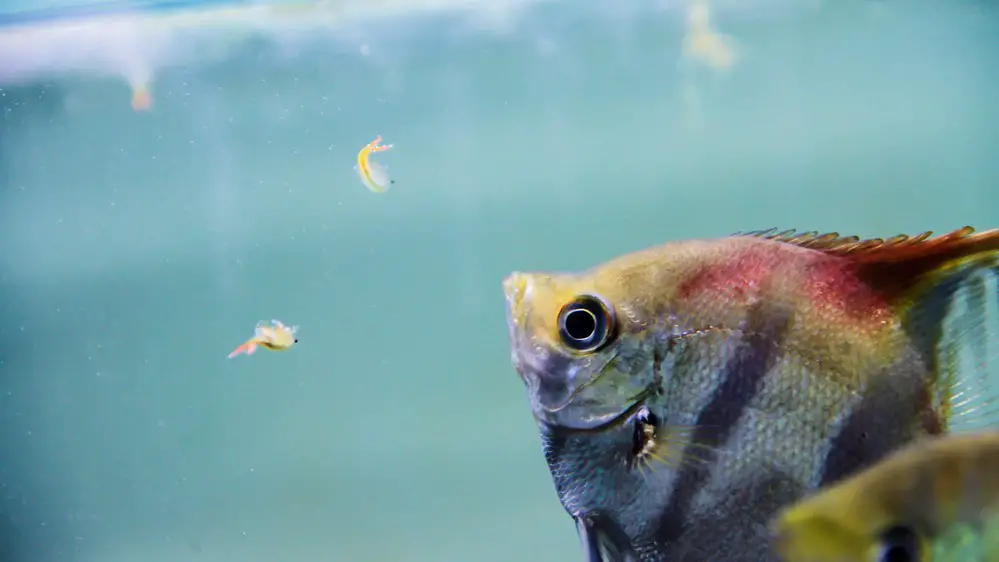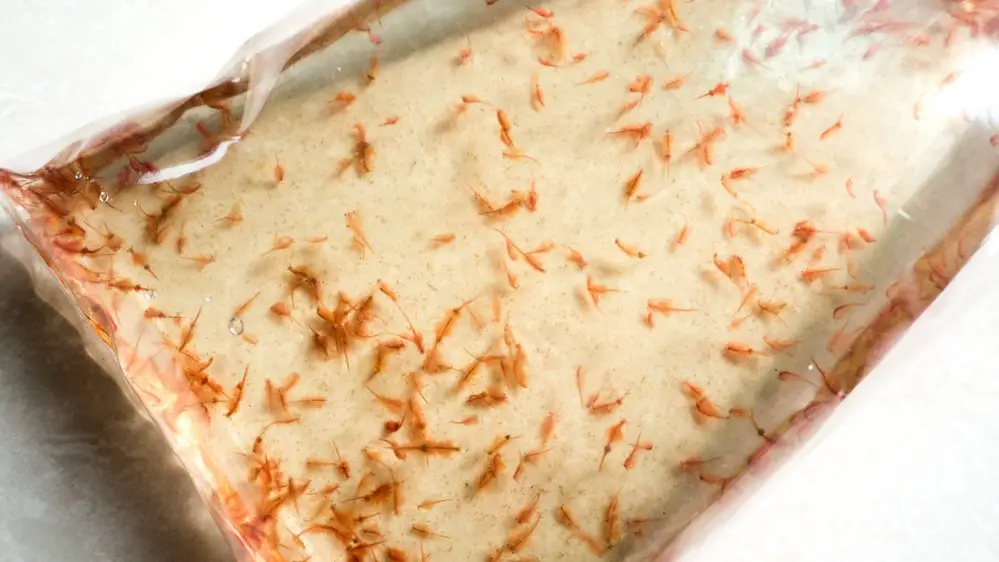Have you ever watched a nature documentary and seen the brutal, eat-or-be-eaten world of the animal kingdom? Now, imagine turning your gaze to your peaceful shrimp tank. Would your shrimp partake in such savage behavior? Would they, for instance, eat brine shrimp?
No, shrimp do not typically eat live brine shrimp. They seem to prefer their food in a state of decay, indicating a preference for detritus-based meals.
Hello, shrimpfam! Let’s dive into a topic that has puzzled me for quite some time. As a seasoned shrimp keeper, I’ve often experimented with different types of food to keep my little crustaceans happy and healthy.
One such experiment involved introducing live brine shrimp into the tank. To my surprise, my shrimp showed no interest in these potential meals. They seemed to prefer their brine shrimp lifeless, a preference that extended to other live feed like bloodworms.
This observation led me down a rabbit hole of research and experimentation. Over the years, I’ve noticed that our little friends won’t even nibble on a living plant. It’s as if they have a sixth sense, an indicator of decay that we humans are not privy to. This indicator seems to guide them towards what’s edible and what’s not.
me down a rabbit hole of research and experimentation. Over the years, I’ve noticed that our little friends won’t even nibble on a living plant. It’s as if they have a sixth sense, an indicator of decay that we humans are not privy to. This indicator seems to guide them towards what’s edible and what’s not.
In this post, we’ll delve into this fascinating behavior, exploring the dietary preferences of shrimp and the possible reasons behind them. So, whether you’re a seasoned shrimp keeper or a newbie to the shrimp nation, buckle up for an exciting exploration into the world of shrimp dining habits. Let’s get started, shall we?
What is the natural diet of shrimp in an aquarium?
In the tranquil world of an aquarium, shrimp are diligent janitors, always on the move, scavenging and cleaning. Their diet is primarily detritus-based, meaning they feed on organic matter that has begun to decay. This includes plant matter, dead organisms, and even bits of fish food that have sunk to the bottom of the tank.
that have sunk to the bottom of the tank.
Shrimp are opportunistic feeders, meaning they’ll eat almost anything they come across that fits their dietary preferences. This can range from algae growing on the tank’s sides to biofilm forming on various surfaces. Biofilm, a layer of microorganisms that contains bacteria, fungi, and protozoa, is particularly nutritious for shrimp and is a staple in their diet.
While it’s true that shrimp will eat a variety of foods, they seem to have a preference for food that’s already in a state of decay. This is why they often ignore live food like brine shrimp or bloodworms, opting instead for the same food once it has died and started to decompose.
Understanding the natural diet of shrimp can help aquarium owners provide a balanced and nutritious diet for their shrimp, ensuring their health and longevity. It’s also important to remember that while shrimp are excellent cleaners, they can’t replace regular tank maintenance and water quality checks. After all, a clean tank is a happy tank, for both you and your shrimp.

How do shrimp identify their food?
Despite their small size, shrimp have a fascinating way of identifying their food. They are equipped with a pair of long, thin, sensitive antennae that they use to explore their environment and locate food. These antennae are covered in tiny hairs that can detect changes in the water’s chemistry, helping the shrimp find food particles in the water or on surfaces.
Shrimp also have a pair of maxillipeds, small appendages near their mouths, which they use to handle food and bring it to their mouth. These maxillipeds have tiny hairs that can taste and smell, providing the shrimp with information about the food’s edibility.
Interestingly, shrimp seem to have a preference for food that’s in a state of decay. This suggests that they may be able to detect certain chemical changes that occur during decomposition, guiding them to their next meal. This is why shrimp often ignore live food like brine shrimp or bloodworms, but will readily eat the same food once it has died and started to decompose.
This ability to identify food plays a crucial role in the shrimp’s survival, allowing them to find food in the often murky waters of their natural habitats. Understanding this behavior in an aquarium can help shrimp keepers provide appropriate food and maintain a healthy environment for their shrimp.

Why don’t shrimp eat live brine shrimp?
The dietary preferences of shrimp can seem puzzling at first, especially when they ignore seemingly perfect food sources like live brine shrimp. However, the answer lies in their natural feeding habits and physical capabilities.
Shrimp are scavengers by nature, preferring to feed on detritus, or decaying organic matter. This includes dead plants, decomposing animals, and leftover food particles. They are not naturally predatory and do not have the physical adaptations to chase and capture live prey. Their feeding strategy is more about foraging and scavenging than hunting.
When it comes to live brine shrimp, these tiny creatures are quite active and mobile, making them difficult for shrimp to catch. Shrimp, with their scavenging lifestyle, are not equipped to pursue such elusive prey.
Moreover, shrimp seem to prefer food that’s in a state of decay. They may be able to detect certain chemical changes that occur during decomposition, which signal to them that the food is edible.
So, while live brine shrimp are perfectly safe for shrimp, they do not align with the shrimp’s natural feeding habits and preferences. This is why shrimp keepers often observe their shrimp ignoring live brine shrimp, but readily eating the same once they have died and started to decompose.
Understanding this behavior can help shrimp keepers provide a diet that aligns with their shrimp’s natural preferences, promoting their health and well-being.

What are the implications of shrimp dietary preferences for shrimp keepers?
Understanding the dietary preferences of shrimp has significant implications for those who keep them in aquariums. It informs the type of food that should be provided, the feeding schedule, and even the overall maintenance of the tank.
Firstly, knowing that shrimp prefer detritus-based meals means that shrimp keepers should provide food that aligns with this preference. This can include specially formulated shrimp pellets that break down slowly, allowing the shrimp to feed on them over time.
It can also include blanched vegetables, which can start to break down in the water, mimicking the decaying matter that shrimp would naturally feed on.
Secondly, the fact that shrimp are scavengers and will eat leftover food particles has implications for how much food is added to the tank. Overfeeding can lead to poor water quality, as uneaten food will decay and potentially lead to harmful ammonia spikes.
Therefore, shrimp keepers need to monitor their tank closely to ensure that all food is being consumed and that the water parameters remain stable.
Lastly, the preference of shrimp for decaying matter means that they can play a role in maintaining the cleanliness of the tank. They will eat decaying plant matter and other detritus, helping to keep the substrate clean.
However, it’s important to remember that shrimp are not a replacement for regular tank maintenance. Regular water changes and substrate cleaning are still necessary to maintain a healthy environment for the shrimp.
Understanding the dietary preferences of shrimp can help shrimp keepers provide the best care for their pets. It can guide feeding practices, tank maintenance, and even the selection of tank mates, ensuring a healthy and harmonious aquarium environment.

In a Nutshell: Understanding Shrimp Dietary Preferences
To put it simply, shrimp are fascinating creatures with unique dietary preferences. They are scavengers by nature, preferring to feed on detritus or decaying organic matter.
This includes dead plants, decomposing animals, and leftover food particles. They are not naturally predatory and do not have the physical adaptations to chase and capture live prey, such as brine shrimp.
Understanding these preferences is crucial for shrimp keepers. It informs the type of food to provide, the feeding schedule, and even the overall maintenance of the tank. By aligning with the shrimp’s natural feeding habits, shrimp keepers can ensure the health and well-being of their pets.
Observing your shrimp and adjusting their care based on their behavior is the key to successful shrimp keeping.
If you need any further help understanding your shrimp’s dietary preferences or any other aspect of shrimp care, please don’t hesitate to reach out.
Check out Aquarium Shrimp Keeping on Facebook if you can’t reach me here. We have a community of experienced and novice shrimp keepers who are always ready to help.
Happy Shrimp Keeping, shrimpfam!
FAQ on Shrimp Dietary Preferences
Q. What do shrimp eat in an aquarium?
A. Shrimp are scavengers by nature, feeding primarily on detritus or decaying organic matter. This includes dead plants, decomposing animals, and leftover food particles. They are not naturally predatory and do not have the physical adaptations to chase and capture live prey.
Q. Can shrimp eat live brine shrimp?
A. While live brine shrimp are safe for shrimp, they do not align with the shrimp’s natural feeding habits. Shrimp are scavengers and prefer food that’s in a state of decay. They are not equipped to pursue elusive prey like live brine shrimp.
Q. Do shrimp eat bloodworms?
A. Yes, shrimp can eat bloodworms, but typically only after they have died and started to decompose. Shrimp are not naturally predatory and do not chase after live prey.
Q. Can shrimp eat plant matter?
A. Yes, shrimp can eat plant matter, particularly if it’s in a state of decay. They are known to feed on dead plants and algae in the tank.
Q. How do shrimp find their food?
A. Shrimp use their long, sensitive antennae to explore their environment and locate food. They can detect changes in the water’s chemistry, helping them find food particles. They also use a pair of maxillipeds, small appendages near their mouths, to handle and taste the food.
